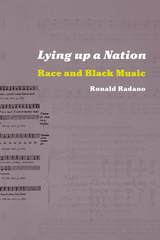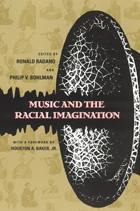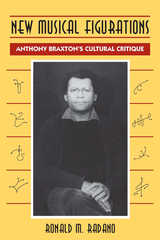3 books about Radano, Ronald M.

Lying up a Nation
Race and Black Music
Ronald M. Radano
University of Chicago Press, 2003
What is black music? For some it is a unique expression of the African-American experience, its soulful vocals and stirring rhythms forged in the fires of black resistance in response to centuries of oppression. But as Ronald Radano argues in this bracing work, the whole idea of black music has a much longer and more complicated history-one that speaks as much of musical and racial integration as it does of separation.
[more]

Music and the Racial Imagination
Edited by Ronald M. Radano and Philip V. Bohlman
University of Chicago Press, 2001
"A specter lurks in the house of music, and it goes by the name of race," write Ronald Radano and Philip Bohlman in their introduction. Yet the intimate relationship between race and music has rarely been examined by contemporary scholars, most of whom have abandoned it for the more enlightened notions of ethnicity and culture. Here, a distinguished group of contributors confront the issue head on. Representing an unusually broad range of academic disciplines and geographic regions, they critically examine how the imagination of race has influenced musical production, reception, and scholarly analysis, even as they reject the objectivity of the concept itself.
Each essay follows the lead of the substantial introduction, which reviews the history of race in European and American, non-Western and global musics, placing it within the contexts of the colonial experience and the more recent formation of "world music." Offering a bold, new revisionist agenda for musicology in a postmodern, postcolonial world, this book will appeal to students of culture and race across the humanities and social sciences.
Each essay follows the lead of the substantial introduction, which reviews the history of race in European and American, non-Western and global musics, placing it within the contexts of the colonial experience and the more recent formation of "world music." Offering a bold, new revisionist agenda for musicology in a postmodern, postcolonial world, this book will appeal to students of culture and race across the humanities and social sciences.
[more]

New Musical Figurations
Anthony Braxton's Cultural Critique
Ronald M. Radano
University of Chicago Press, 1993
New Musical Figurations exemplifies a dramatically new way of configuring jazz music and history. By relating biography to the cultural and musical contours of contemporary American life, Ronald M. Radano observes jazz practice as part of the complex interweaving of postmodern culture—a culture that has eroded conventional categories defining jazz and the jazz musician. Radano accomplishes all this by analyzing the creative life of Anthony Braxton, one of the most emblematic figures of this cultural crisis.
Born in 1945, Braxton is not only a virtuoso jazz saxophonist but an innovative theoretician and composer of experimental art music. His refusal to conform to the conventions of official musical culture has helped unhinge the very ideologies on which definitions of "jazz," "black music," "popular music," and "art music" are founded.
New Musical Figurations gives the richest view available of this many-sided artist. Radano examines Braxton's early years on the South Side of Chicago, whose vibrant black musical legacy inspired him to explore new avenues of expression. Here is the first detailed history of Braxton's central role in the Association for the Advancement of Creative Musicians, the principal musician-run institution of free jazz in the United States. After leaving Chicago, Braxton was active in Paris and New York, collaborating with Philip Glass, Steve Reich, Frederic Rzewski, and other composers affiliated with the experimental-music movement. From 1974 to 1981, he gained renown as a popular jazz performer and recording artist. Since then he has taught at Mills College and Wesleyan University, given lectures on his theoretical musical system, and written works for chamber groups as well as large, opera-scale pieces.
The neglect of radical, challenging figures like Braxton in standard histories of jazz, Radano argues, mutes the innovative voice of the African-American musical tradition. Refreshingly free of technical jargon, New Musical Figurations is more than just another variation on the same jazz theme. Rather, it is an exploratory work as rich in theoretical vision as it is in historical detail.
Born in 1945, Braxton is not only a virtuoso jazz saxophonist but an innovative theoretician and composer of experimental art music. His refusal to conform to the conventions of official musical culture has helped unhinge the very ideologies on which definitions of "jazz," "black music," "popular music," and "art music" are founded.
New Musical Figurations gives the richest view available of this many-sided artist. Radano examines Braxton's early years on the South Side of Chicago, whose vibrant black musical legacy inspired him to explore new avenues of expression. Here is the first detailed history of Braxton's central role in the Association for the Advancement of Creative Musicians, the principal musician-run institution of free jazz in the United States. After leaving Chicago, Braxton was active in Paris and New York, collaborating with Philip Glass, Steve Reich, Frederic Rzewski, and other composers affiliated with the experimental-music movement. From 1974 to 1981, he gained renown as a popular jazz performer and recording artist. Since then he has taught at Mills College and Wesleyan University, given lectures on his theoretical musical system, and written works for chamber groups as well as large, opera-scale pieces.
The neglect of radical, challenging figures like Braxton in standard histories of jazz, Radano argues, mutes the innovative voice of the African-American musical tradition. Refreshingly free of technical jargon, New Musical Figurations is more than just another variation on the same jazz theme. Rather, it is an exploratory work as rich in theoretical vision as it is in historical detail.
[more]
READERS
Browse our collection.
PUBLISHERS
See BiblioVault's publisher services.
STUDENT SERVICES
Files for college accessibility offices.
UChicago Accessibility Resources
home | accessibility | search | about | contact us
BiblioVault ® 2001 - 2024
The University of Chicago Press









